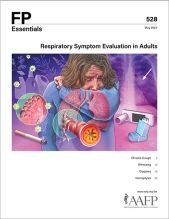
This clinical content conforms to AAFP criteria for CME.
Hemoptysis is the expectoration of blood from the lower respiratory tract and has an extensive differential diagnosis that can be divided into pseudohemoptysis, infectious, neoplastic, vascular, autoimmune, and drug-related categories. Pseudohemoptysis is the expectoration of blood from a different source and needs to be ruled out. Clinical and hemodynamic stability must be established first. Chest x-ray is the initial imaging examination for all patients with hemoptysis. However, advanced imaging, such as a computed tomography scan, is helpful for further evaluation. Management aims to ensure patient stabilization. Most diagnoses are self-limited, but bronchoscopy and transarterial bronchial artery embolization can be used to manage massive hemoptysis.
Case 4. ZD is a 72-year-old patient who comes to your office after 4 days of morning cough with blood-tinged sputum. He has a history of smoking and chronic bronchitis, but reports that he stopped smoking 5 years ago. He has no history of recent travel, fever, dyspnea, or night sweats; however, he has experienced a 5-kg (11-lb) weight loss in the past 2 months. Physical examination findings are normal except for bibasilar crackles on lung auscultation. Chest x-ray results are normal.
Definition and Prevalence
Hemoptysis refers to the expulsion of blood from the lower respiratory tract. It can occur with or without expulsion of mucus.130 Hemoptysis predominantly affects older individuals with a mean age of 62 years and males more than females in a ratio of 2:1.131 It occurs in approximately 10% of patients with chronic lung disease and approximately 0.1% and 0.2% of outpatient and inpatient populations, respectively.130 On the basis of these statistics, primary care physicians may see approximately 4 to 5 patients/year with hemoptysis.132
Subscribe
From $350- Immediate, unlimited access to FP Essentials content
- 60 CME credits/year
- AAFP app access
- Print delivery available
Edition Access
$44- Immediate, unlimited access to this edition's content
- 5 CME credits
- AAFP app access
- Print delivery available
